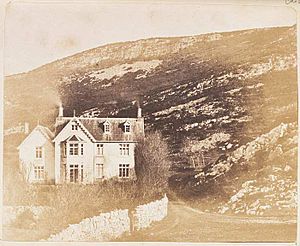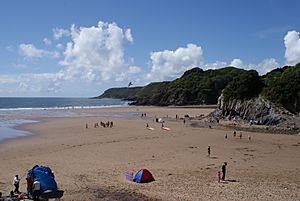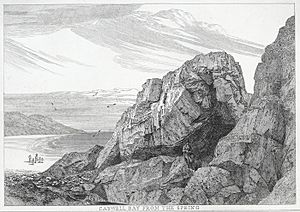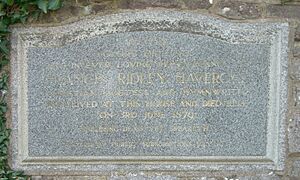Caswell Bay facts for kids
Caswell Bay is a popular sandy beach located on the south-east side of the Gower Peninsula in Swansea, Wales. Its Welsh name is Bae Cas-wellt, which means "straw fortress". This beach is a favorite spot for families, people on holiday, and surfers. It often receives the Blue Flag award, which means it's a very clean and safe beach.
Contents
Things to Do and How to Get There
It's easy to get to Caswell Bay by car or by bus from Swansea Bus Station. There's a big car park where you can pay to park. Buses also go to nearby villages like Oystermouth and Mumbles.
You can walk along the coast from Caswell Bay. To the east, there's a nice path leading to Langland Bay. To the west, a more natural path takes you to Brandy Cove and Pwlldu Bay.
Food, Shops, and Toilets
Caswell Bay has a cafe that's open all year round. There's also a beach shop where you can buy things. You'll find public toilets and outdoor showers, which are great after a swim!
Beach Safety and Activities
Swansea City Council provides a Lifeguard service every day from early May to September. This makes the beach safe for swimming and playing.
Caswell Bay is a great place for surfing. There's even a surf school that offers lessons all year. In 2020, a special surf centre opened next to the car park. It's designed to help everyone, including people with disabilities, enjoy surfing. The bay is also famous for its rock pools, where you can explore sea creatures at low tide.
Nature Nearby
Behind the bay is the Bishop's Wood nature reserve. This is a rare type of woodland with limestone. You can visit the nature reserve on your own at any time. If you want to learn more, you can arrange educational tours through the Bishop's Wood countryside centre.
History of Caswell Bay
In the early 1800s, a lot of the land around Caswell Bay was bought by a man named John James for his daughter and son-in-law.
Early Photography and Homes
In 1846, a part of the land was sold to John Dillwyn Llewelyn. He was a very early photographer in the 1800s. Llewelyn built a holiday home called Caswell Cottage. This cottage stood where the public car park is now. In 1854, even Prince Albert asked to see some of Llewelyn's photos of Caswell Bay. Sadly, in 1878, Llewelyn's thirteen-year-old grandson drowned while swimming in the bay.

After Mrs. Charles Morgan passed away in 1877, her land was divided among her six children. Another family, the Davenports, bought land on the western side of the bay. They built a large house called Redcliffe. A famous poet named Vernon Watkins, who was friends with Dylan Thomas, lived in Redcliffe in the late 1920s. This house was taken down in the 1960s to build the Redcliffe apartments you see today.
Three of Mrs. Charles Morgan's daughters, Emma, Agnes, and Alice, made Caswell Bay their home. They built many of the houses that are still there, including their own home, Bay House. They also planted many of the unique pine trees around the bay.
In 1879, a religious poet and hymn writer named Frances Ridley Havergal died in a house near Caswell Bay. There is a special plaque that remembers her.
Old Structures and Landmarks
In 1883, a wind pump was built on Redley Cliff to pump water to houses. It was damaged in a storm and stopped being used by 1900. It was removed in 1930 for safety. On top of Redley Cliff, there are also signs of an old Iron Age fort.
In the 1890s, a large concrete water tank was built at the bottom of the cliff. It collected water from a small spring and is still there today. Around the same time, a pump house was built. It was damaged by the sea, so a new one was built near the road. After World War I, the pump house was no longer needed and became a cafe for a while. Part of it is still there.
The Caswell Bay Court apartments, built in the 1990s, now stand where the Caswell Bay Hotel used to be. The hotel started as a simple house in the 1850s.
Recent Recognition
In 2006, Caswell Bay was named one of the top 50 beaches in the UK by The Guardian newspaper.
In 2020, the world's first special surf centre for people with disabilities was built at Caswell Bay. Volunteers helped build it as part of a TV show called DIY SOS for BBC Children in Need.
See also
 In Spanish: Bahía Caswell para niños
In Spanish: Bahía Caswell para niños




